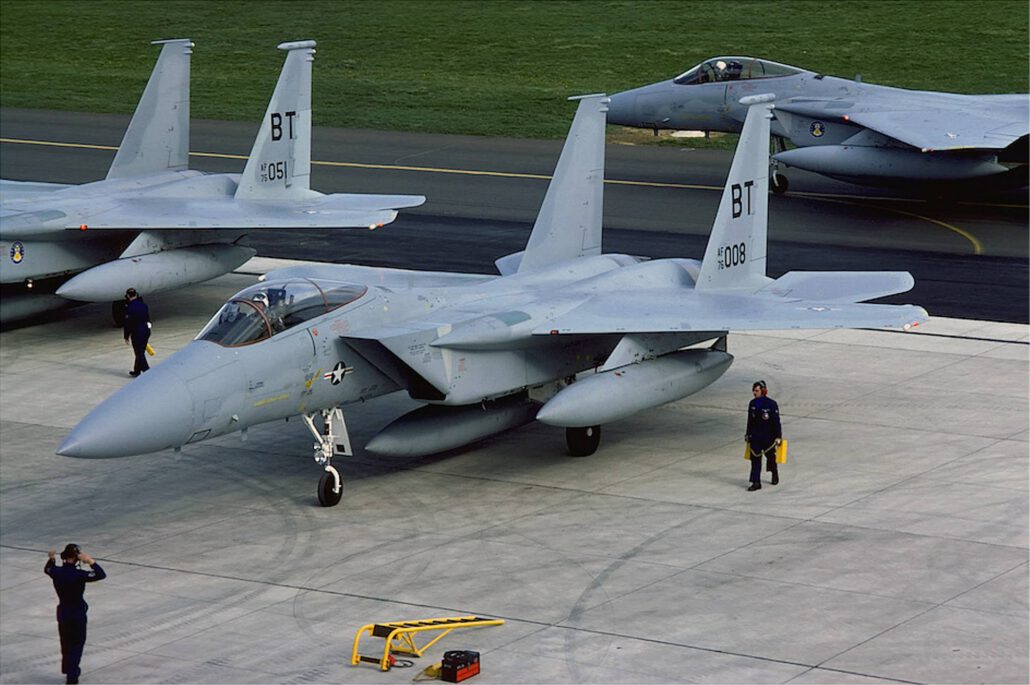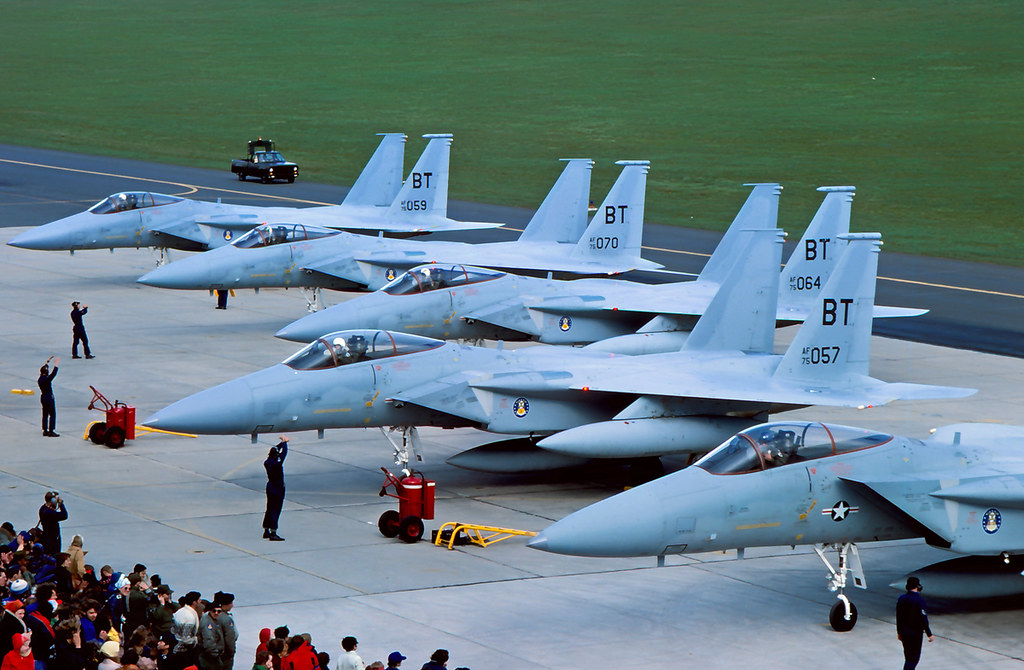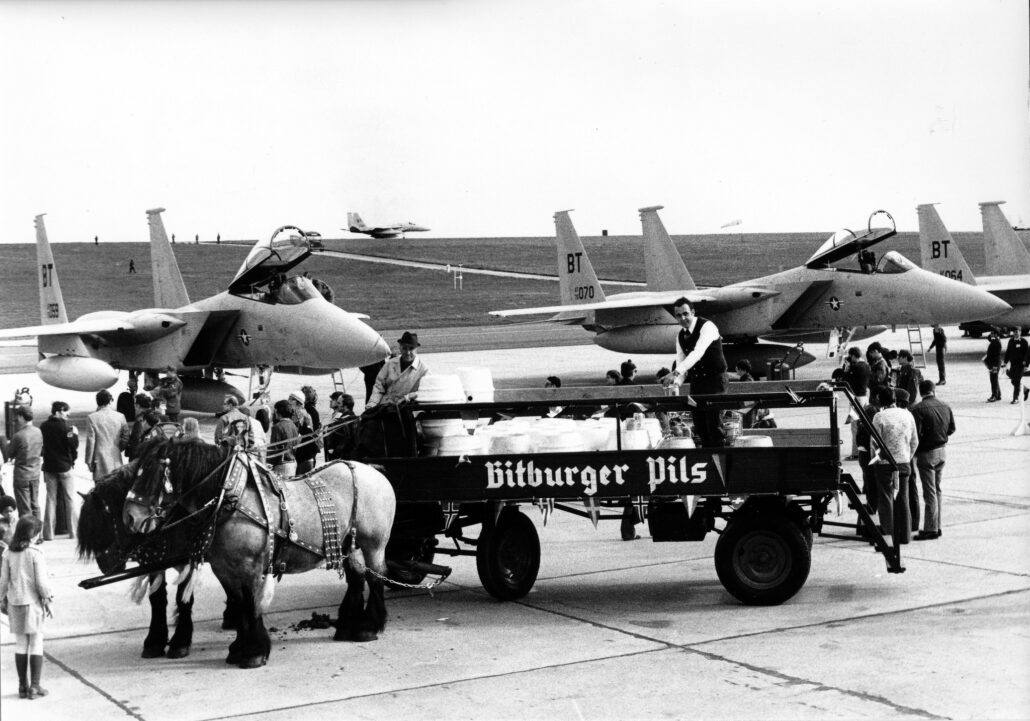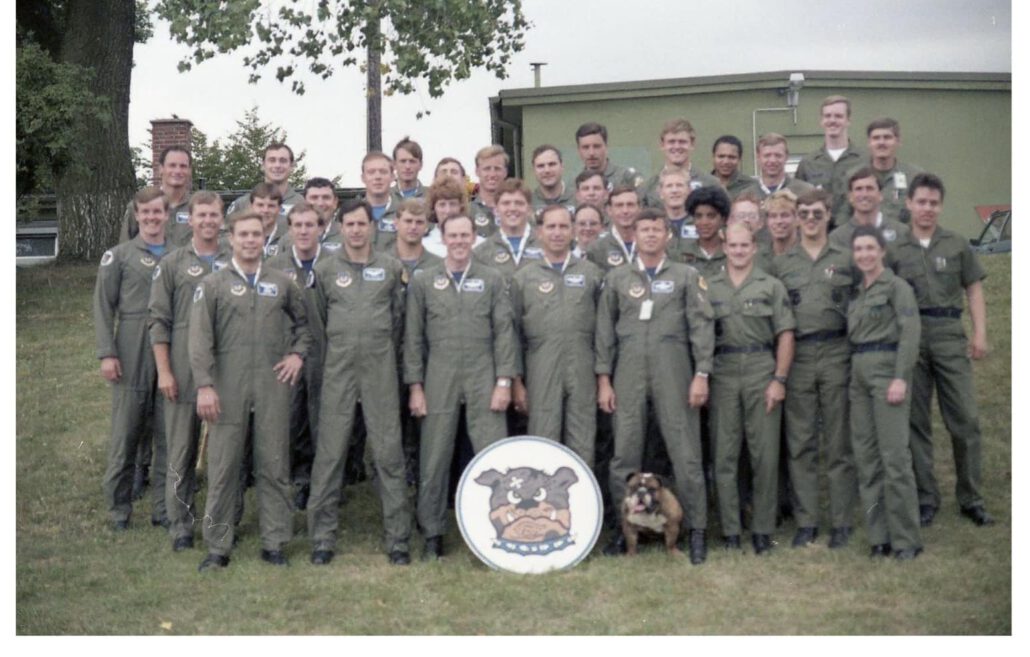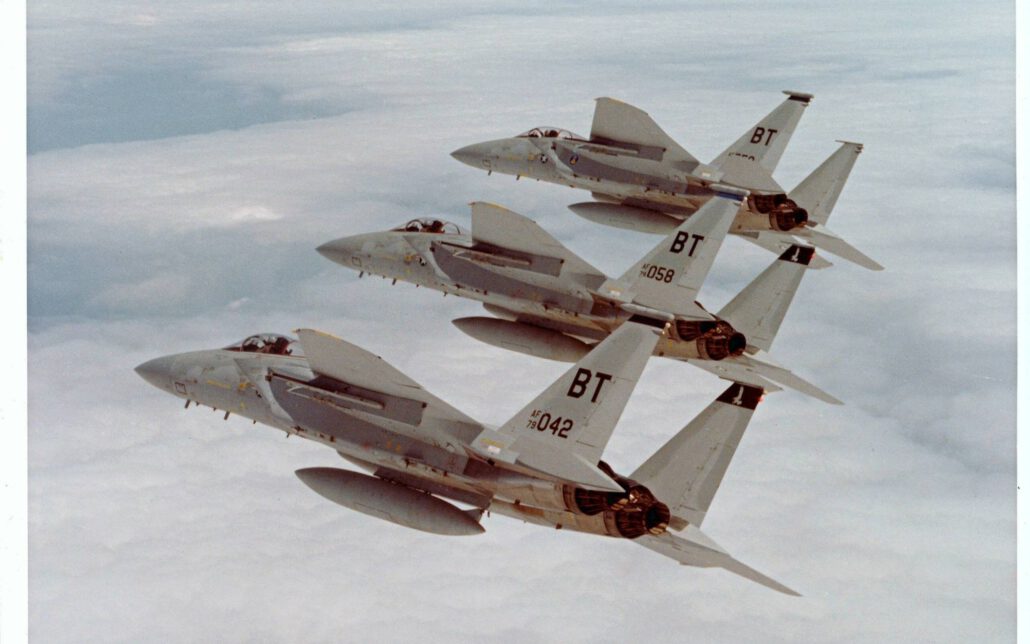On 27 April 1977, Bulldog pilots flew the first 23 Eagles to Europe on an historic, non-stop deployment from Langley AFB, Virginia to Bitburg, Germany. Operation READY EAGLE became a success when, 18 hours
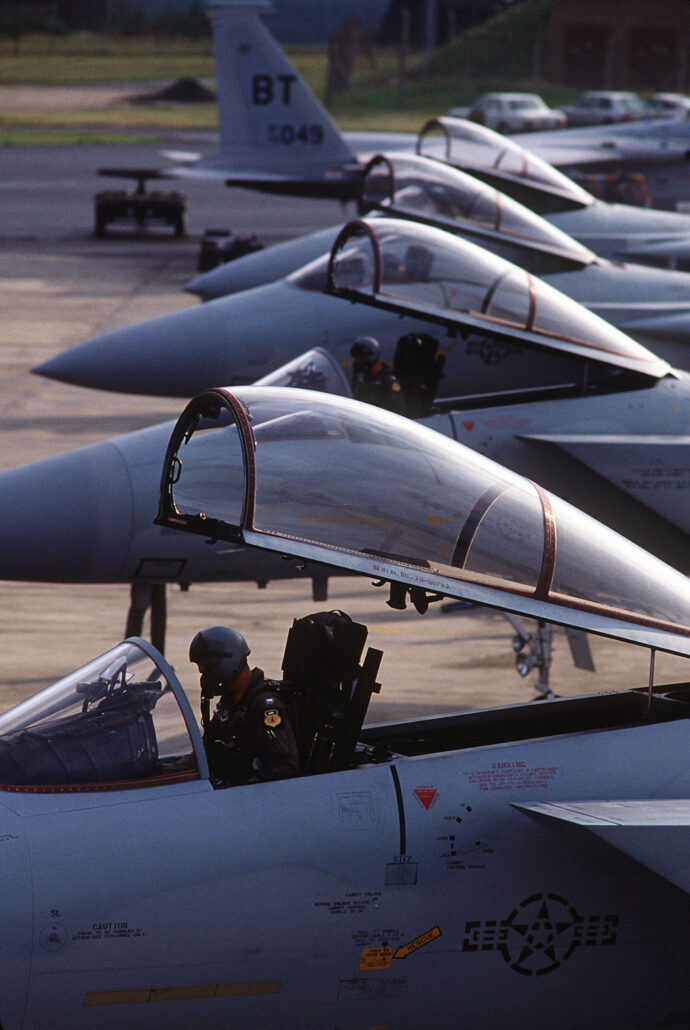
after arrival at Bitburg, Bulldog pilots were sitting 5-minute alert status with two of those F-15s.
On 26 May 1977, after less than one month on station, the Bulldogs were declared Europe’s first Operationally Ready F-15 squadron. One week later, they proved themselves in a NATO Operational Readiness Inspection (ORI) with a 100 percent kill rate on the Dart, and a 98 percent Intercept Hack rate.
In 1978, the Bulldogs were featured as part of the McDonnell-Douglas film, “Eagles in Defense of Europe.” In October 1979, the 525 flew the first training missions at the new Air Combat Maneuvering Instrumentation (ACMI) range at Decimomannu Air Base, Sardinia, Italy. In 1983, USAFE once again nominated the 525 for the prestigious Hughes Trophy.
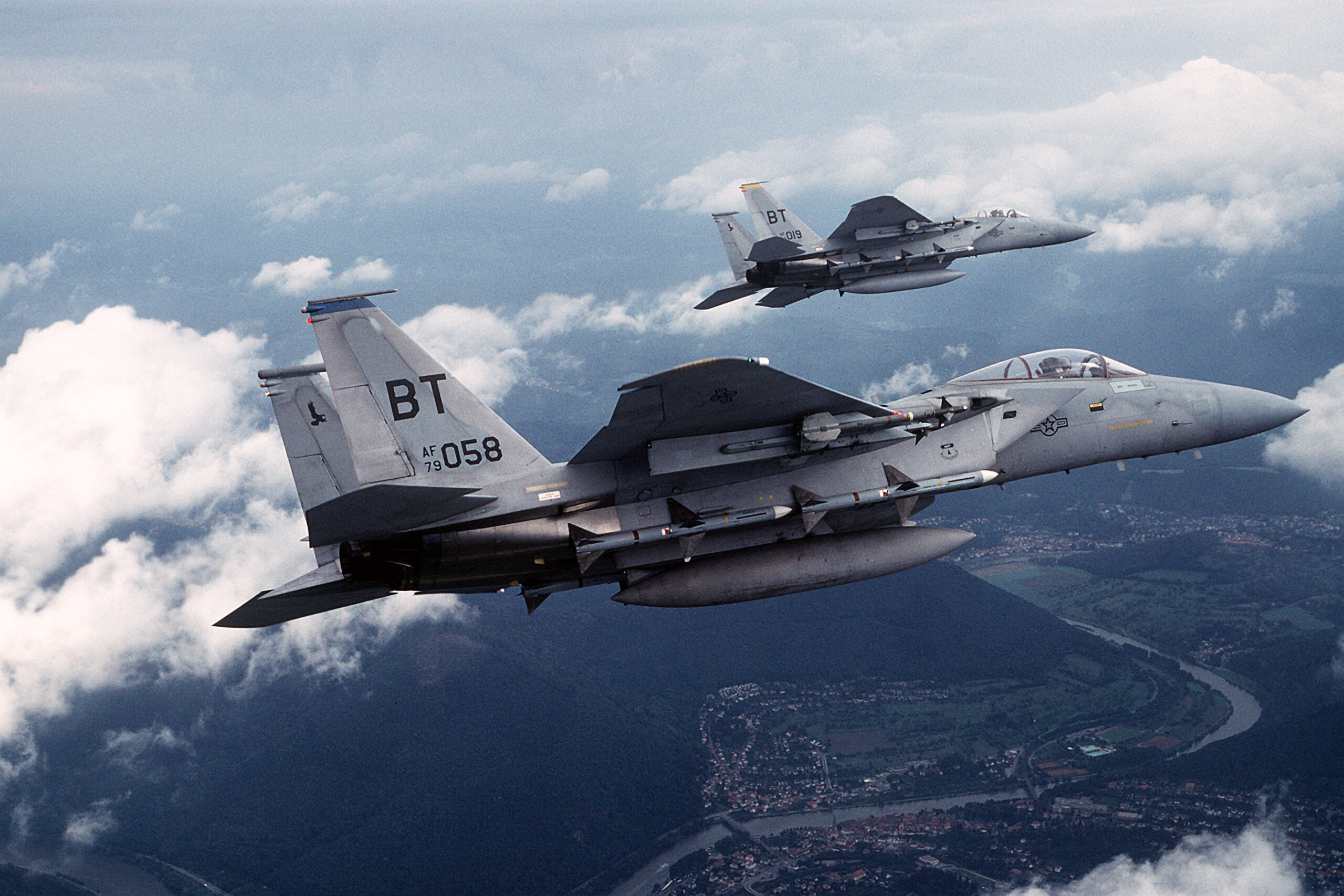
In 1984, the Bulldogs participated in an exchange with the French Air Force, sending six F-15s to Orange Air Base, France in exchange for four Mirage F-1’s. The French pilots flew for several weeks with the 525 and operated out of Bulldog operations facilities at Bitburg. In 1986, and again in 1987, the 525 deployed to Morocco and set up bare base operations at Sidi Sliminc. The 525 lived and functioned for four weeks out of tents and flew their missions with F-1’s and F-5’s from Morocco. In November 1988, the Bulldogs won USAFE’s Excalibur air-to-air weapons competition. In April 1989, the Bulldogs set a wing record for the most sorties in one month, flying 678 sorties, with 14 aircraft, while deployed to Decimomannu Air Base, Italy.
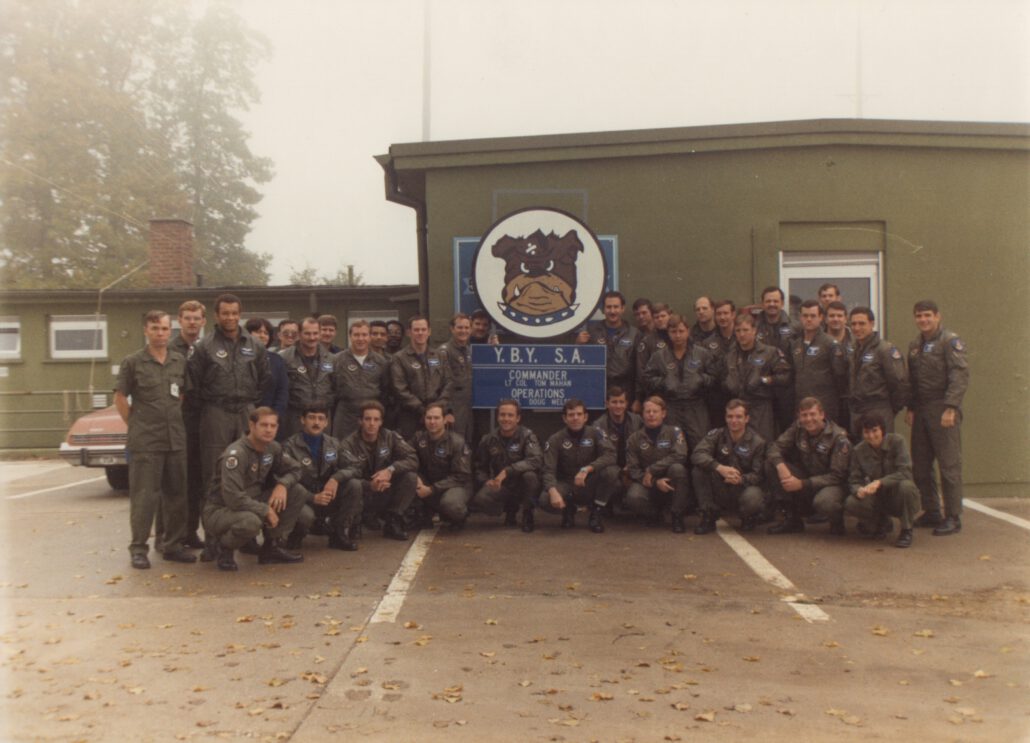
In August 1990, Saddam Hussein, leader of a repressive and bloody regime in Iraq, attacked and occupied the small, oil-rich nation of Kuwait. The United States, along with the United Nations, condemned this action and called for Iraq’s withdrawal from Kuwait by the 15th of January 1991. Iraq did not comply.
In December 1990, the 525 deployed to Incirlik Air Base, Adana, Turkey for “Just another weapons training deployment.” When the Bulldogs arrived at Incirlik Air Base with their F-15s, they joined American F-16’s from Spain, F-111’s from England, Wild Weasels from Germany, KC-135 Stratotankers from Texas, and E-3 AWACS and other electronic combat support aircraft from around the world. These units, deployed to Incirlik Air Base, formed the 7440th Combat Wing (Provisional) – the United States Air Force’s first composite wing.
On the night of 17 January 1991, Bulldogs flew in the first strike against Iraq by PROVEN FORCE aircraft. On 19 January 1991, two Bulldogs used AIM-7 Sparrow radar missiles to destroy two Iraqi Mirage F-1’s. During the next six weeks, until the cease-fire, the 525 flew around the clock, protecting two strikes per day and one strike each night. PROVEN FORCE strikes targeted military airfields, nuclear and chemical facilities, communications centers, power plants, and oil refineries and storage facilities in northern Iraq. By the middle of February, PROVEN FORCE was attacking Baghdad. In addition to protecting strikers, the 525 was frequently tasked to man barrier caps in eastern Iraq to destroy Iraqi fighters attempting to flee to Iran. These missions, often lasting in excess of five hours, required the Bulldogs to operate over 150 miles behind enemy lines without any support assets.
The Bulldogs performed magnificently in Operation PROVEN FORCE. Flying 1329 combat sorties for a total of 3550 combat hours, the squadron shot down six enemy aircraft. More importantly, not a single PROVEN FORCE aircraft was lost in combat during the war. On 13 March 1991, the 525 returned to Bitburg in victory. The celebration was brief, however, as the Bulldogs deployed back to Incirlik Air Base on 5 April 1991 to support Operation PROVIDE COMFORT.
Following the war against Iraq, numerous Kurdish refugees fled northward from the remaining forces of Saddam Hussein. The United States initiated a vast airlift operation, named Operation PROVIDE COMFORT, to drop food and supplies to these refugees concentrated in Iraq along the Turkish border. Because tensions between the Iraqi and Allied forces in the area remained quite high, the 525 was called back to Turkey in April 1991 to protect the vulnerable Allied cargo aircraft. In addition, the 525 was tasked, as part of the operation, to fly at low altitude over Iraq and provide intelligence updates of Iraqi troop and equipment locations.
Once again, the 525 performed its mission honorably. Between the 5th of April and the 25th of May 1991, the Bulldogs flew 285 sorties over Iraq in support of Operation PROVIDE COMFORT. Just as before, not a single Allied aircraft was lost in Iraq due to hostile fire.
Throughout the rest of 1991 and into 1992, the 525th Tactical Fighter Squadron served its nation with honor and pride. The Bulldogs deployed to Leeuwarden Air Base, The Netherlands during October 1991. In December 1991, the Bulldogs deployed to RAF Bentwaters, England to train on the new North Sea ACMI range. The final weapons training deployment for the 525th Tactical Fighter Squadron was at Leeuwarden Air Base, The Netherlands from 16 March 1992 to 27 March 1992,
The 525th Tactical Fighter Squadron “Bulldogs” deactivated at Bitburg Air Base, Germany on 1 April 1992, closing the history of one of the United States finest fighting units – fifty years, one Cold War, and two shooting wars after it opened. Though deactivated for the time being, the Bulldogs look forward with the hope to reactivate again, as a fighter squadron, and serve our great nation.
THE BULLDOG EMBLEM
The Bulldog emblem was officially approved by the Department of the Air Force on 29 September 1955. According to the original approving orders from 1955, the emblem design was to be:
“On a white disc, edged light blue, the full face of a caricatured bulldog, in shades of light brown and tan, detail and outlines black, eyeballs, teeth, and patch on his head white, iris black, pupils green, wearing a collar of the second color, spiked white.”
The bulldog was selected as the squadron mascot and emblem due to the following
:
”The bulldog is a fighter. The dog’s expression, with broken tooth, patch on head, and spiked collar, symbolizes FIGHT, without specifically showing aircraft, wings, flame, jets, or armament, giving the emblem a long-range suitability to a tactical fighter outfit. The blue in the collar is the squadron color.”
————————————————————————
THE BULLDOG MASCOT HISTORY
The first verified four-legged member of the squadron was “Helen”, in 1962. Records of when Helen arrived, and how she departed are somewhat fuzzy, but she was replaced by “Andy” in 1966. Andy was well known for frequently standing on the O’Club bar and lapping beer. Also known as “fat dog”, Andy’s beer drinking habit was probably responsible for his obesity as well as his’ early demise in 1969. In 1970, the 525 got a new mascot named “Brutus” who earned a club card so he could regularly attend happy hour with the rest of the Bulldogs at the Officers Club. Following Brutus, the squadron had “Romel” who stayed with the Bulldogs until the 525 stopped flying the F-4 in 1977. “Butkus” arrived in October 1977, and was frequently seen at Bitburg varsity football games. Butkus became quite attached to the squadron commander, however, and left with him in 1979. “Bo” followed Butkus. Named after her Hollywood namesake fop being a perfect 10. Bo only lasted a year before expiring on the operating table. In 1982, the squadron replaced Bo with “Apex”. Having his own club card, Apex often visited the O’Club and sat at the bar wearing his best spiked collar. Apex lived in the squadron during the day and rotated quarters at night with various squadron members – depending on who was serving the best dinner. Known to instantly attack any clipboard in sight, Apex stayed with the squadron for nine years until his death in 1991.
————————————————————————
BULLDOG TRADITIONS
1. The squadron title is pronounced, “five-two-five.”
2. The mascot is a purebred English bulldog. New mascots should be flown to the 525 from England, supersonic, in a squadron aircraft, by a Bulldog lieutenant.
3. Prior to becoming Mission Ready, new Bulldog pilots are required to wear nametags labeled “Bullpup” while in the squadron area.
4. After achieving Mission Ready status, new Bulldog pilots are required to go through the 525 Secret-Sacred Ceremony. This ceremony, conducted by the Squadron Commander, is as follows:
– Conducted no later than the first Friday after achieving Mission Ready status.
– Attended only by Mission Ready Bulldogs.
– The “Demo Pilot “will be the ‘shortest’ Bulldog present.
– Further Secret-Sacred events may only be passed on by word of mouth.
5. Bulldogs will wear the Bulldog pin at all times while in civilian attire. Failure to comply will result in the violator buying drinks for all other Bulldogs present. The Bulldog pin may only be earned by the following two methods:
– Successful completion of the Mission Ready check and Secret-Sacred ceremony by a Bulldog pilot.
– Intimate relations with a Mission Ready Bulldog pilot following his Secret-Sacred ceremony.
6. 525 Day, the 25th of May, will be celebrated annually as a squadron holiday. All festivities for the holiday will start promptly at 5:25 P.M.
7. When a married Bulldog leaves the squadron, a bachelor Bulldog always presents flowers to the departing wife.
8. Whenever the question is asked, “Is there a Bulldog in the house?”, all Bulldogs reply, “You bet your sweet ass there is!”
Squadron photos
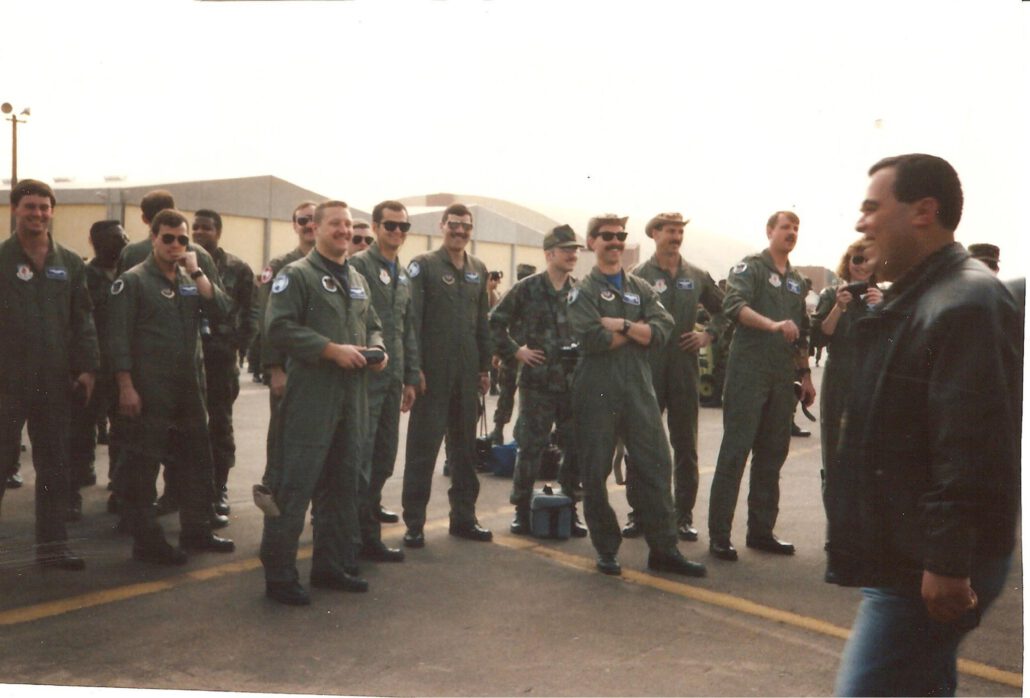
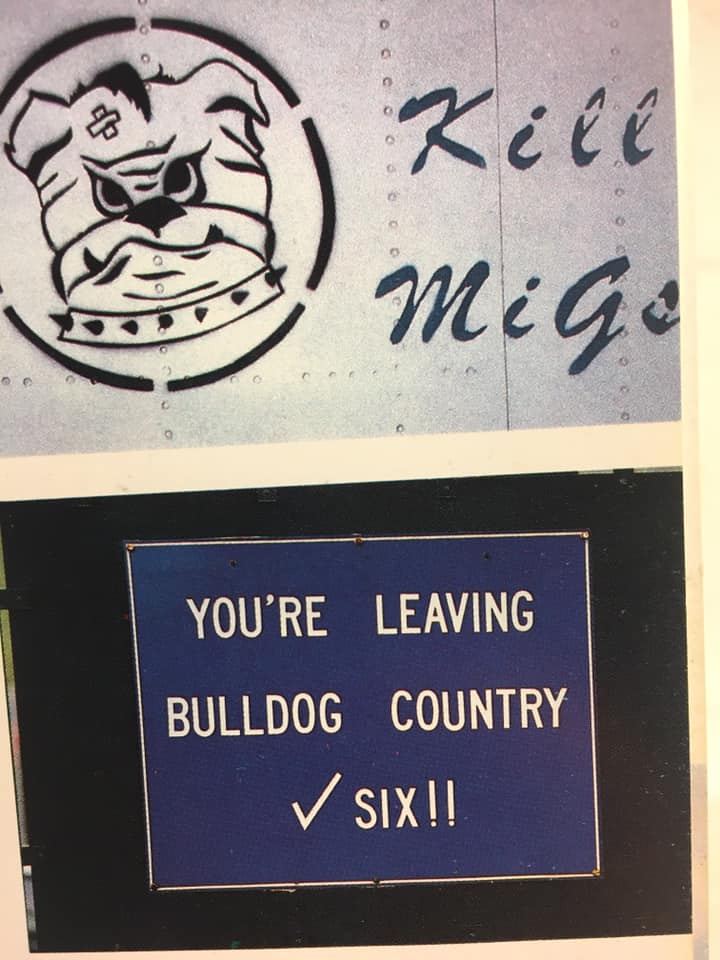
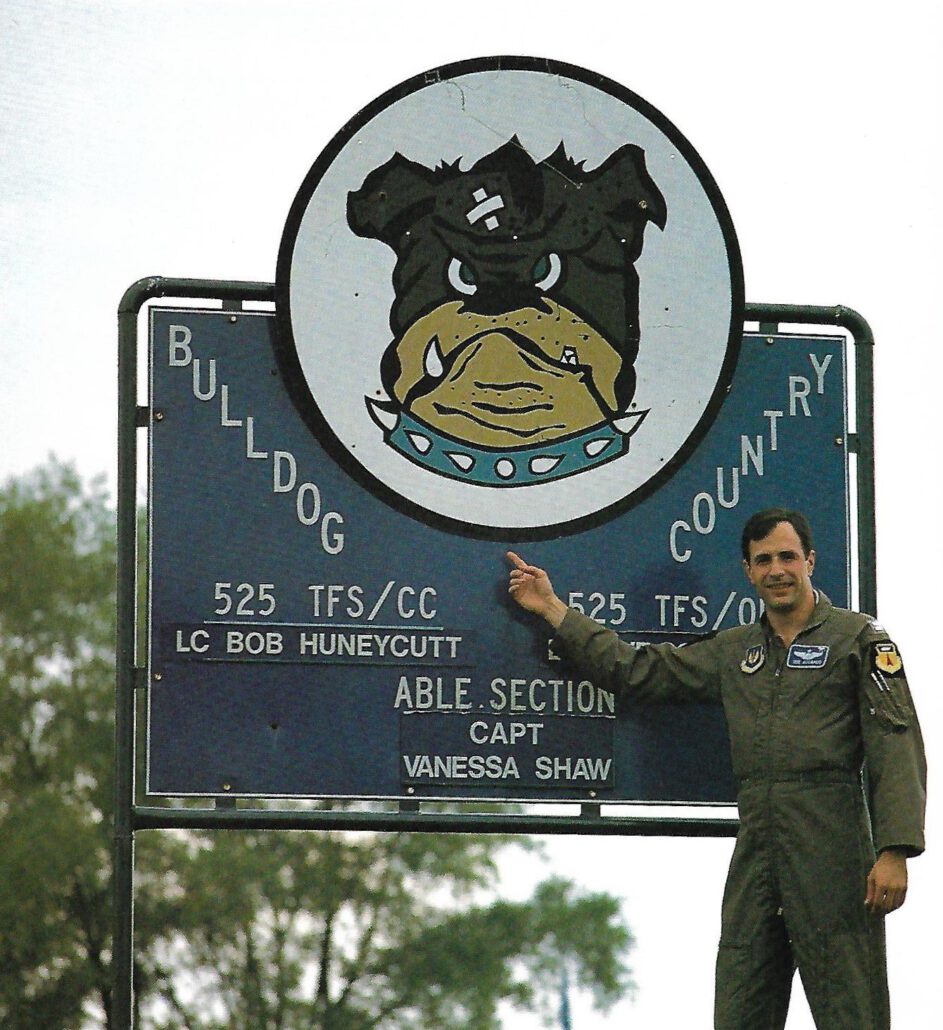
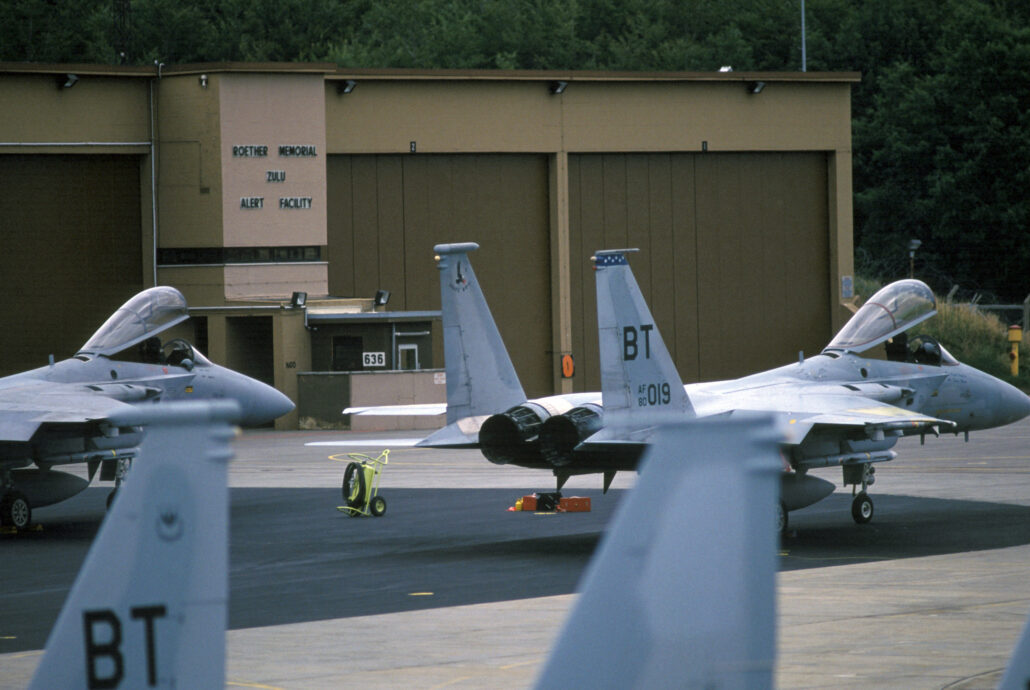
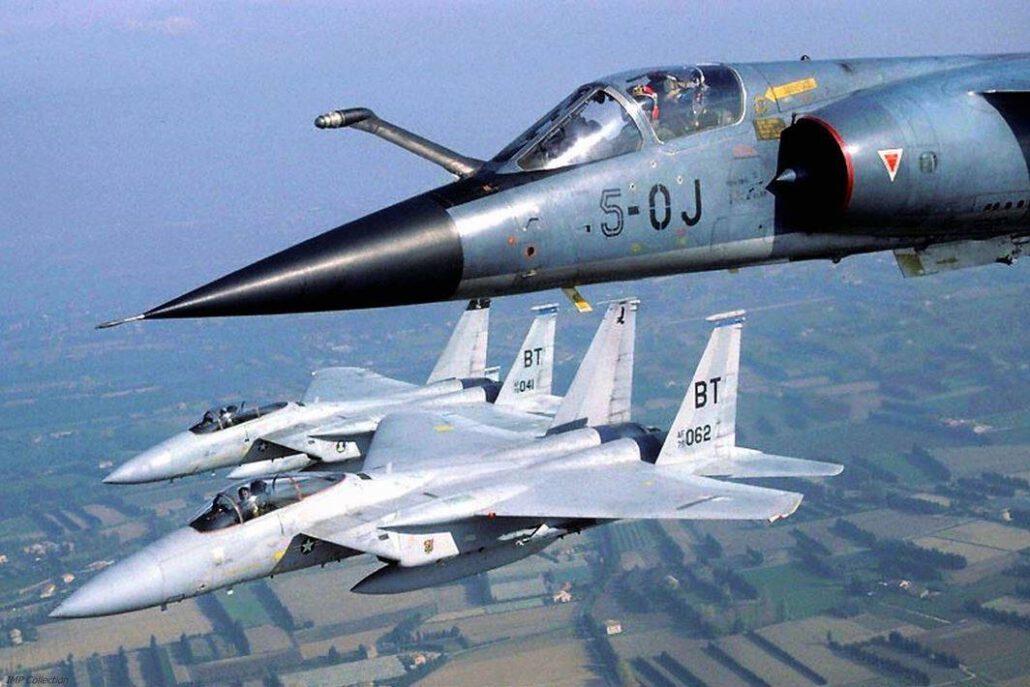
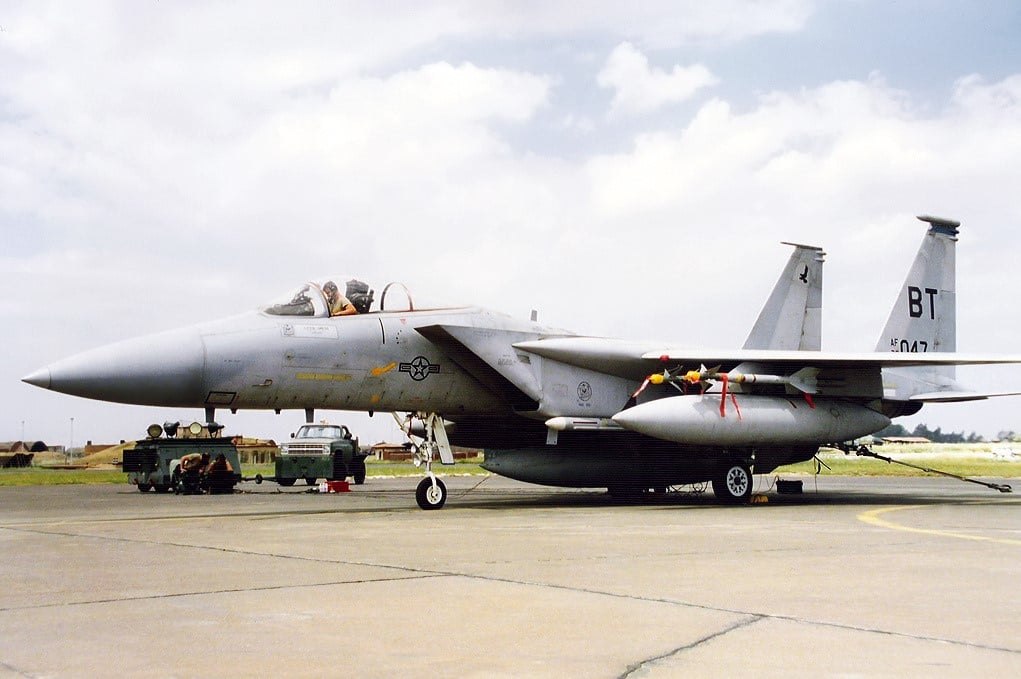
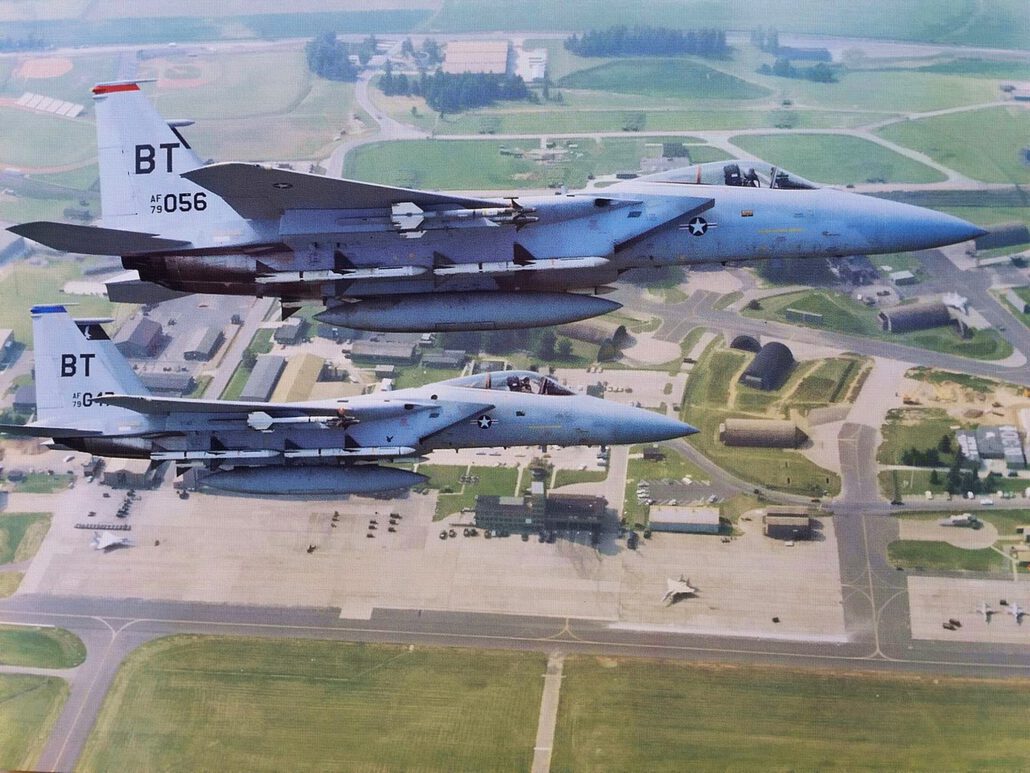
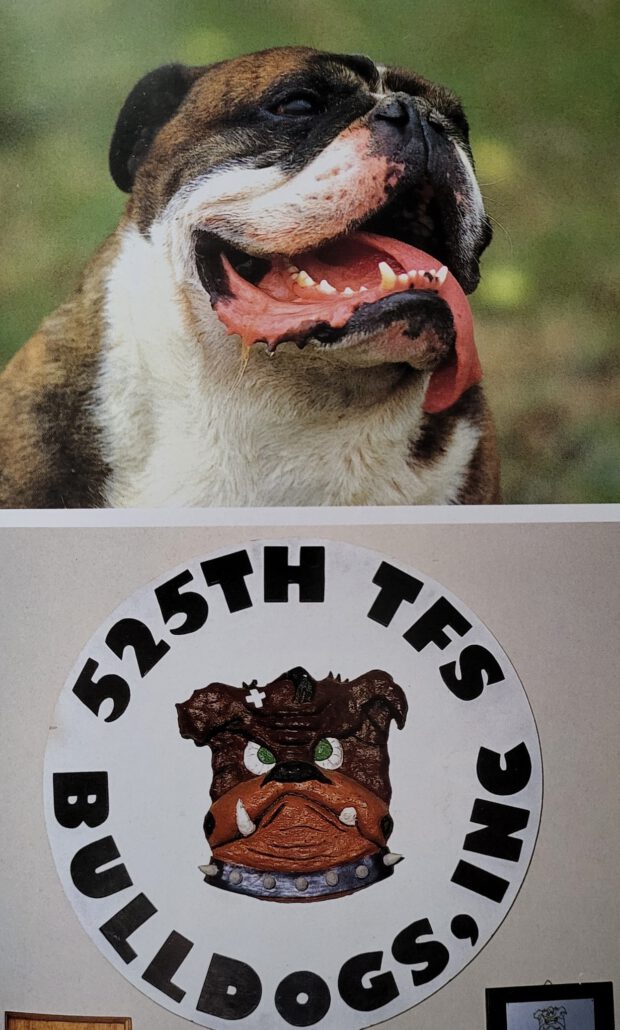
Operation Ready Eagle
Operation Ready Eagle” brought twenty three F-15’s across the atlantic on the 27th of april 1977. They were all carrying the wing code ‘BT’ in black and some already had the wing badge on the intakes. They were flown by 525 TFS who had been working up at Langley AFB(KLFI), VA for some weeks previously, and the idea was that the squadron should be fully combat ready as soon as they arrived in germany. Serials were:
| 525 TFS / 36 TFW “BT” | |
|---|---|
| F-15A: | 75-0051 / 75-0056 / 75-0057 / 75-0059 / 75-0062 / 75-0063 / 75-0064 |
| 75-0065 / 75-0066 / 75-0069 / 75-0070 / 75-0071 / 75-0072 / 75-0073 | |
| 75-0076 / 75-0077 / 76-0008 / 76-0011 / 76-0013 / 76-0014 | |
| F-15B: | 75-0087 / 75-0088 / 76-0124 |
